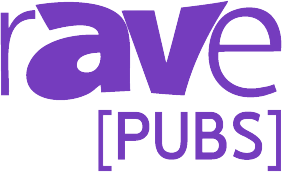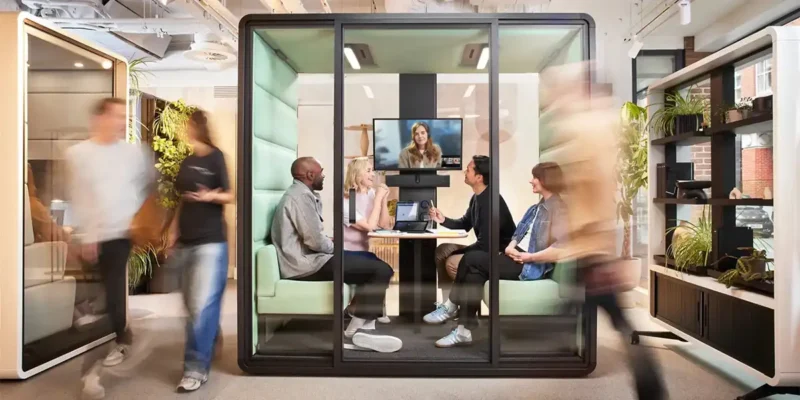Temperature Check Results: Where UC and Hybrid Workspaces Stand Now

By Steph Beckett and Clara Mello
We thought it’d be a good idea to look back at the responses from some of our past Temperature Check surveys this year and give you all a glance at what everyone said. This past March, our survey focused on unified communications and hybrid workspaces. The rAVe team wanted to know where you see the future of UC heading — and what you think our meetings will look like down the line. We also talked to some industry experts and had them weigh in on the data.
First, we asked for your thoughts on the biggest UC-based trend you think will matter most to AV over the next year.

Nearly 60% of you said AI-powered meeting enhancements are going to impact the industry the most.
Briana Henning, chief revenue officer at RoomReady, said this is on track with what she’s seeing in the market.
“AI has been part of meeting rooms for years,” she said. “Speaker tracking, noise suppression, and intelligent framing have already been delivered through the manufacturers and platforms
we work with. What’s changing now is how quickly AI features are evolving (at both the
hardware and platform layers), especially around real-time transcription, voice
recognition, and smart automation.”
David Danto, principal analyst at TalkingPointz, echoed that he’s hearing a lot about AI from all corners of AV when it comes to collaboration — but many of the meeting enhancements in question, especially transcription services like meeting notes, still have a long way to go.
“AI is currently going through a tremendous hype cycle, and in many cases, it’s wildly misunderstood, he said. “Meeting notes, for example, are often treated as authoritative records, but they’re only as accurate as the AI that created them — and transcription errors can have serious legal consequences — all records are ‘discoverable.’ All it takes is accidentally changing one ‘can’ to a ‘can’t’ and suddenly the written record misrepresents the meeting.”
The real power, he said, lies in some of the other up-and-coming AI-based tech.
“The truly transformative capabilities are things like real-time translation in a speaker’s own voice, sentiment analysis, automated camera direction, and algorithms that clean up poor audio to near-studio quality, he said. “When these tools work invisibly — enhancing the experience without calling attention to themselves — that’s when users will actually feel the impact.
Next, we asked about the future of hybrid meetings. Are we team room-based tech or team BYOD?

The majority (about 69%) of you said you see the future being both. In other words, the industry doesn’t seem to be going all in on just one direction. But then — is it hard to make products for customers who want the best of both worlds? And how are manufacturers responding?
Josh Blalock, chief product analyst at Jabra, said it’s all about making flexible products. (For Jabra, that’s the PanaCast 50 VBS — and now the 40, too.)
“The reality of most customer environments is that one size rarely fits all spaces,” he said. “That is why we have evolved our offerings to meet customers where they are; that often means bringing solutions to the market that offer enough flexibility to enable BYOD where it is needed, while easily using these same solutions for fully integrated in-room systems.”
But that leads me to my next question: Why are we asking for both?
Henning says it’s a few things.
“COVID gave everyone pause and rethink how to make their existing hardware work with the meeting platforms they suddenly had to rely on from home,” she said. “Hardware and software weren’t evolving together fast enough to keep up, and BYOD stepped in to fill that gap. It gave users the flexibility they needed right away, without waiting on full alignment between platforms and hardware. That flexibility proved valuable, and now we’re in a world where BYOD and fully integrated UC both have a place.”
She also said that at RoomReady, they aren’t pushing one or the other.
“We typically see integrated UC systems make the most sense in executive spaces,
customer-facing rooms, or anywhere reliability and consistency matter,” she said. (Complimenting these rooms solutions with a BYOD option gives an executive user support relief when the invite comes in!) BYOD tends to work well in flex spaces, hoteling rooms, or lower-use areas where users just want to walk in and connect their own way.”
Now for our final question: How are we doing when it comes to meeting equity? Is it even a thing?

A little over 50% of you said you think that while the industry is improving its ability to give remote and in-room participants the same experience, we still have a long way to go.
Danto said a lot of that “long way to go” is due to a lack of true interoperability.
“We already have the technology to create room systems that could understand what platform a meeting is on and automatically launch the appropriate native experience with all the right controls,” he said. “But manufacturers and platform providers have a financial incentive to keep users locked into their ecosystems. Until they give up those walls, achieving seamless equity between in-room and remote participants will remain more aspiration than reality.”
Blalock said part of the disconnect is that manufacturers aren’t shifting their mindsets. Achieving true meeting equity means providing full solutions — not just products. One product can’t solve meeting equity by itself.
“We have found that not feeling clearly seen or heard is one of the biggest reasons that meeting equity continues to be a major challenge for many users,” he said. “Specifically, quality audio or video solutions, or rather the absence of these solutions across all participants within a meeting, is one of the biggest blockers to feeling fully included and involved. If you as an organization are bringing an industry-leading solution to the in-room meeting participants but ignoring the technological needs and struggles of participants that might be at home or on the go, the equity story has just broken down.”
So there you have it. It’s a fascinating time to be in AV — and an even more fascinating time to be in the unified communications space. The AI hype train is definitely here, but some of its promises may end up being real game-changers. We’re asking for both BYOD and room-based systems, proving we value flexibility and the ability to meet however we’re most comfortable. And while we’re pushing for meeting equity, we’re not quite there yet.
Thanks for participating in our Monthly Temperature Check survey — and thanks for reading. Keep an eye out for next month’s survey!





